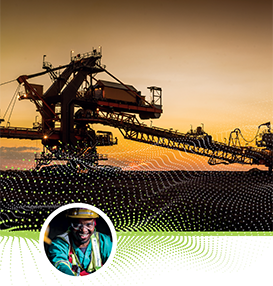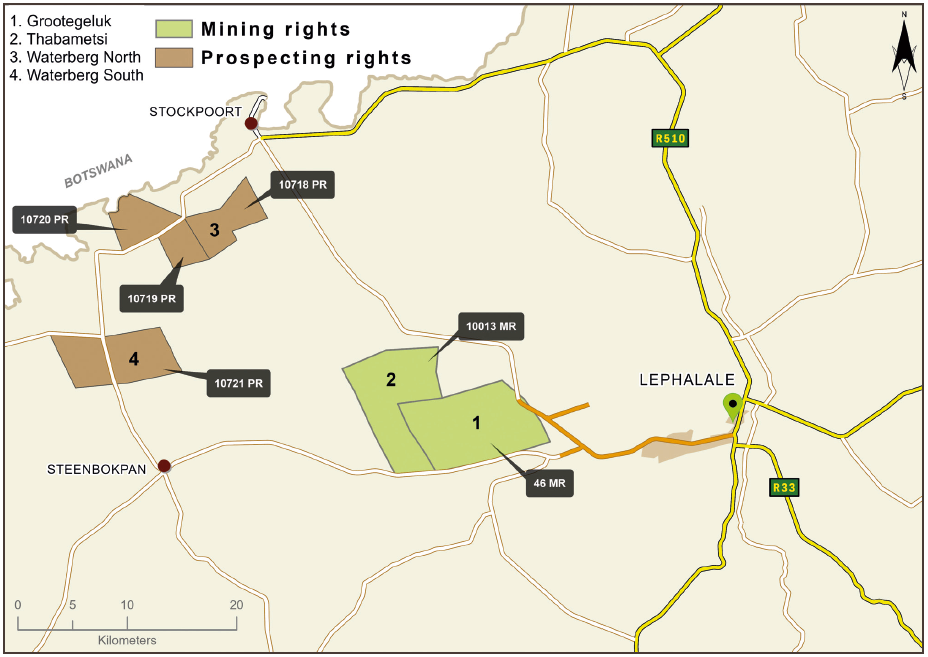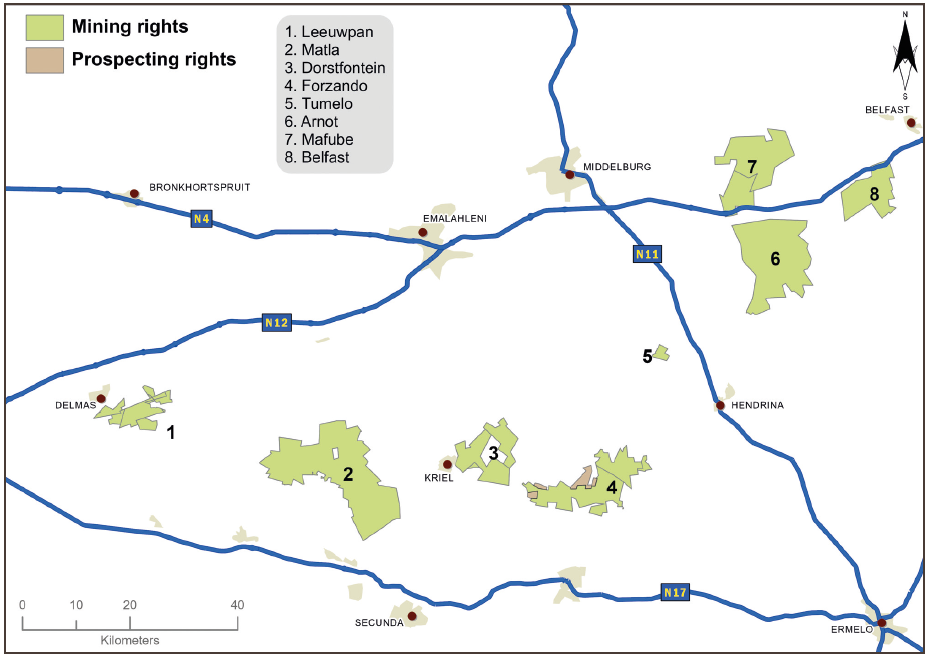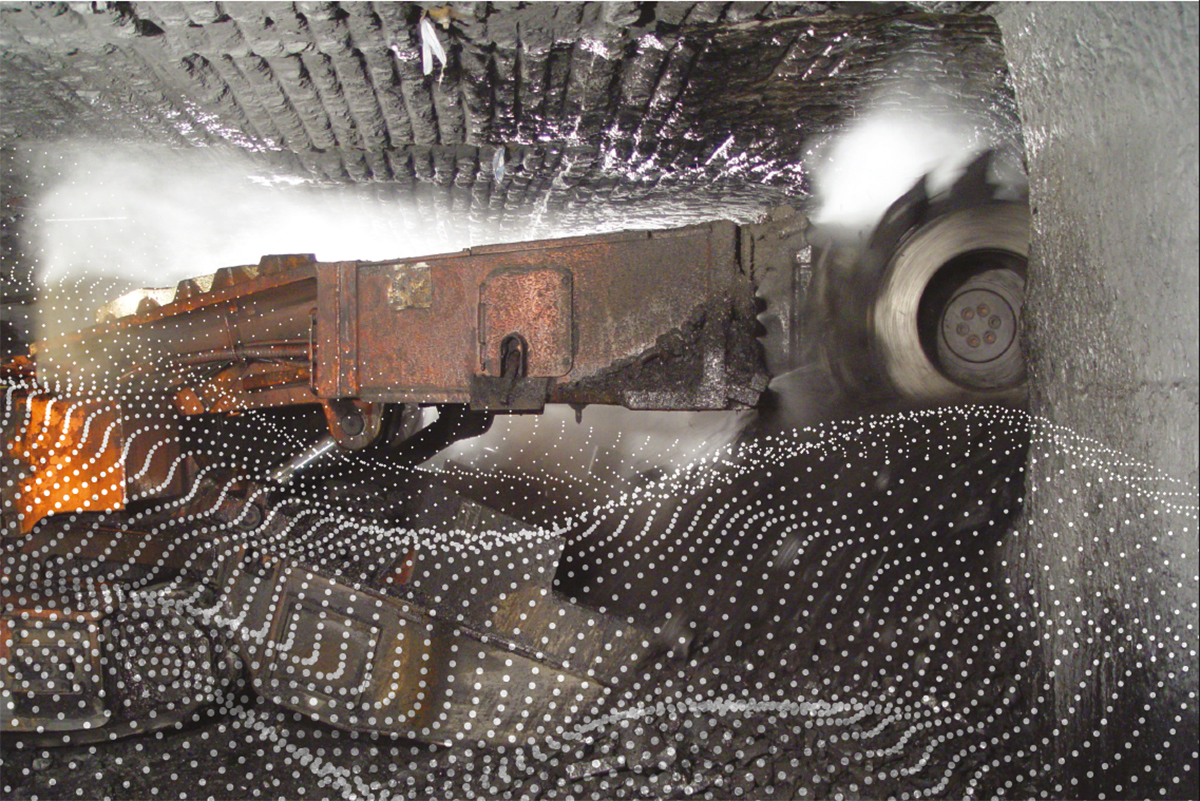Integrated report 2019

The Mineral Resources and Mineral Reserves summarised below are reported as those remaining on 31 December 2019 and compared with the corresponding estimates reported on 31 December 2018. Mineral Resources are reported including Mineral Resources that have been converted to Mineral Reserves and at 100% Exxaro ownership, irrespective of the individual operation or project's attributable shareholding. We do, however, also report Mineral Resources that fall within our LoM plan to enhance transparency. An exception is our reporting for Gamsberg and Black Mountain as Base Metal figures from Vedanta Resources represent Resources excluding those Mineral Resources converted to Mineral Reserves.
It is important to note that reported estimates are not an inventory of all mineral occurrences identified but a reasonable estimate of those which, under assumed and justifiable technical, environmental, legal and economic conditions, may be economically extractable at present (Mineral Reserves) and eventually in future (Mineral Resources).
Mineral Resources and Mineral Reserves are estimated on an operational or project basis and in line with the SAMREC Code for African properties, except for Vedanta's property, and the JORC Code 2012 for Australian and Vedanta properties. For Coal Resources and Coal Reserves under Exxaro management's control, estimation is in line with the South African National Standard: South African guide to the systematic evaluation of Coal Resources and Coal Reserves (SANS 10320:2004).
Comprehensive information on each operation under Exxaro management's control that supports the Coal Resource and Coal Reserve estimates is provided in the ancillary section of this report.
Grootegeluk coal mine: At Exxaro's flagship open-pit coal mine producing power-station coal, variously sized metallurgical coal products as well as semi-soft coking coal to local and international customers, there is no material change in the 2019 reporting period.
Thabametsi coal project: At the Thabametsi mining right, an area adjacent to the Grootegeluk operation is earmarked to produce power-station coal to supply a mine-mouth feed independent power producer (IPP) plant. Exxaro is currently ensuring that all compliance actions are executed hence no changes to the Coal Resource or Coal Reserve estimates are reported.
Waterberg North and Waterberg South projects: Four prospecting rights that constitute the two projects areas are in closure and we are conducting all activities in a responsible manner to fulfil the closure requirements.
Figure 4: Exxaro’s mining and prospecting rights in the Waterberg

The Grootegeluk surface coal-mining operation consists of a series of parallel benches advancing progressively across the deposit via a process of drilling, blasting, loading and hauling with truck and shovel fleets. The mining bench definitions in the Vryheid and overlying Volksrust formations coincide with the geological boundaries, resulting in 14 mining benches for saleable products and waste. Mining during the reporting year is reported as 56.2Mt RoM of which approximately 2.4Mt consists of semi-soft coking coal, 1.6Mt metallurgical coal and largest portion of power-station coal (approximately 24.5Mt) dispatched to the Matimba and Medupi power stations.
Geological challenges, as already noted in 2018, are increasing as the mine advances to the west. The upper top benches are thinning and will eventually discontinue due to weathering with only a small portion of bench 2 remaining in the next few years. Weathering is highly irregular, specifically in faulted areas, and impacts mining as well as disrupting downstream beneficiation plant throughput. An increase in faulting, in offset and frequency, is observed within but also to the south and north of the current pit. For the first time, a fault-defined graben structure was encountered within the pit, which presents a risk to the execution of the short-term mine plan and for the routing of the correct RoM to the appropriate coal-handling facilities. Continuous pit mapping, downhole geophysical surveys of all holes, including blast holes, as well as close-spaced infill drilling are employed to target these geological challenges. This high-resolution information enabled the operational team to proactively plan and largely mitigate the geological challenges. During 2019, a significant number of openholes were also drilled, roughly 100m apart and positioned on 250m-spaced north-south profile lines in front of the advancing pit. The aim of the holes was to intersect the overburden as well as the full succession of the Vryheid (multi-seam) and Volksrust (thick-interbedded) coal formations to supplement the existing exploration information. The results delivered significant value regarding overburden characterisation and increased the level of confidence of the geological structures, and the accuracy of our bench/seam definitions in the two formations. The profile drilling will continue in 2020 and beyond, based on the success of the results achieved.
The geological model of Grootegeluk is updated every second year, and information from drilling campaigns in 2017/2018 was included in a geological model update, which is currently being used for the review of the Grootegeluk exploitation strategy. The strategy is considering several potential optimisation scenarios, including a review of the current pit turnaround and backfill strategies as well as the bench definitions to optimise bench height for floor control and decreasing mining losses. The Grootegeluk integrated water use management strategy is progressing well in addressing all water-related aspects to provide a strategy for the optimal use of water throughout the value chain. This project will integrate with the exploitation strategy and is expected to enhance water use and water accumulation within the pit significantly. A study initiated in 2018 to review mining of the significant amount of overburden is in progress. The project investigated a number of options to replace the existing load-and-haul mining method with a more cost-effective alternative by considering mining and transporting overburden material via a bulk-materials handling system. The prefeasibility study is still under way to identify the preferred alternative.
Arnot coal mine: In closure, consent has been received for cession of the mining right.
Matla coal mine: An Eskom-tied underground mine, approvals have been received to execute three expansion projects, namely Matla Mine 1, Mine 2 Incline and Mine 3 Decline to access the large remaining 4 seam and 2 seam underground Coal Reserves. The decline at Matla 3 is in progress and Matla Mine 1 relocation was initiated with first coal expected in the fourth quarter of 2022.
Leeuwpan coal mine: Mining of the OI open-pit reserve area is progressing well.
Belfast coal mine: Early coal was produced in the second quarter, commissioning of the coal-handling facility in the third quarter and the first export coal product in early September of the reporting year.
ECC: The Dorstfontein West Mine Incline to access 4 seam Coal Reserves from existing mining infrastructure has been completed. Mining of 4 seam is progressing well. A study was successfully completed at Dorstfontein East to obtain access to 4 seam lower Coal Reserves through five portals in the current pit 2 open area.
Arnot, an Eskom-tied mine, is in closure after the coal-supply agreement (CSA) with Eskom ended on 31 December 2015. The mine produced thermal coal for over 40 years, using various mining methods, predominantly bord-and-pillar (currently mechanical), opencasting and shortwalling between 1995 and 2005. Exxaro received consent in May 2019 for cession of the mining right to a consortium that will benefit its former employees. Exxaro has reasonable expectation that the transfer will be completed in the first quarter of 2020.
Matla, an Eskom-tied underground operation, extracts coal through three underground mines. Matla extracts 2 seam select and the lower-quality but somewhat thicker 4 seam in a specific scheduled relationship to blend and honour the volume and quality requirements of the Eskom agreement. It is therefore of the utmost importance to have adequate access to quality Coal Reserves to ensure the correct volumes are scheduled for the short, medium and long-term strategies. Both coal seams' mineable Reserves are rapidly diminishing within mines 2 and 3 and the unfortunate closure of Mine 1 due to pillar instability in 2015 placing a burden on the operation to comply with contractual expectations. However, Exxaro has, since closure of Mine 1, accelerated exploration and outlined 2 seam and 4 seam Coal Resources that will be accessed through either new or existing infrastructure.
During this time, annual mining targets were supplemented by the identification of additional potential mineable areas, prioritising exploration activities, and through innovative and adaptable mine planning extract the additional required Coal Reserves. Exploitation of the Mine 3 low coal seam is a clear example of this successful undertaking.
The outcome of the studies to secure long-term Coal Resources resulted in a number of expansion projects. The first was the completion of a relocation investigation that entails developing a new box-cut and tunnels to access the remaining Mine 1, 4 seam Coal Reserves. The study was approved and is currently under construction, expecting first coal in the fourth quarter of 2022. The 4 seam shows consistent continuity in thickness and quality although a number of geological challenges relating to faulting, associated dolerite intrusions and seam floor undulation were identified within the larger project area. The challenges were investigated and subsequently considered during mine planning. The geological challenges will be further investigated through vertical and incline drilling with supplementary surface geophysical surveys in 2020. An important activity to highlight is the continuous assessment of geotechnical accessibility to ensure that all Coal Resources can be accessed in future and successfully converted to Coal Reserves.
Two additional expansion projects, consisting of a decline and incline (respectively) below and above current workings at mines 2 and 3 were approved by Eskom, unlocking seams 2 and 4 Coal Reserves. The decline at Mine 3 with the associated vent shaft, is under construction and first coal is expected in the second quarter of 2020. Matla accesses Coal Reserves under challenging geological and mining conditions. Thinning coal seams, variability in coal quality and roof conditions due to the impact of intrusive dykes and sills, as well as geological faulting, present challenges for coal extraction in a number of mining sections. Focused exploration activities, including surface and downhole geophysical surveys and vertical and horizontal drilling, are employed to proactively outline the impacts on mine planning. Directional surface to seam drilling will be implemented for the first time to investigate a number of prominent geological faults in the Mine 2 Incline project area. The drill rig will be located on two positions where it will drill a number of trails to specifically derisk the planned main developments. The geological model was updated during the reporting year resulting in minor Coal Resource changes. These changes, mining depletion and the disposal of stooping areas to protect surface infrastructure were the primary contributors to Coal Reserve changes. A submission for the renewal of the Matla mining right was submitted on time during the reporting year and Exxaro has reasonable expectation that the approval will be granted.
In line with Exxaro's commitment to unlock value, an expansion project to extend the LoM of Leeuwpan, an open-pit operation in Delmas, Mpumalanga, by 10 years was implemented in 2018. The updated plan incorporates changes in the price structure of the export market with higher prices for lower-energy products leading to higher yields. The road relocation and box-cut of the expansion project were successfully concluded and mining was conducted from the OI pit during the reporting year. An investigation surrounding the OI Reserve resulted in unlocking additional Coal Resources (~2.7Mt) included as Probable Reserves in the LoM until all environmental approvals are secured.
Detailed infill geological investigations and mine planning at the new Belfast coal mine resulted in the successful opening of two box-cuts from which coal was extracted from early March in the reporting year. Results from infill drilling successfully outline the depth of weathering and minimised RoM coal losses during box-cut development. In addition, RoM coal qualities corresponded very well with the predicted coal qualities underpinning the importance of adequate infill drilling during box-cut positioning and design. Additional drilling was conducted to define the depth of weathering along the mine plan edges as well as to confirm a number of seam variability anomalies. Coal Resources occur within most of the mining right whereas the Coal Reserve is limited to the southern mining right area aligned with the existing LoM plan. A project was initiated in 2019 to review the exploitation strategy, including investigation of the economic viability of the northern area.
Figure 5: Exxaro’s mining and prospecting rights in Mpumalanga

The dense medium separation plant was successfully implemented in the third quarter of the reporting period, producing the first export coal product in early September. The Belfast operation is earmarked for RoM of 3.25Mpta, increasing to 4.1Mpta in 2023. The operation is focused on a digital and connected approach, resulting in an integrated and focused workforce driving key work packages for successful early commissioning of the operation.
The ECC complex comprises the Dorstfontein, Forzando and Tumelo operations (Figure 5). The complex comprises DCMW (West), an underground mine, and DCME (East), an opencast operation, as well as Rietkuil (Vhakoni), an adjacent project awaiting approval. The DCMW 4 seam Incline project was implemented in 2018, unlocking 4 seam's lower (S4L) Coal Reserves through an incline in existing mine infrastructure. After the successful development of the incline, mining of the 4 seam coal began and is progressing well. Coal extraction from DCME was executed from open-pits 1 and 2 during the reporting year. A study was initiated to access the substantial 4 seam Coal Resource to the west of the open-pit areas through underground mining. All technical and legal aspects, to obtain access through five portals in the current pit 2 open-pit area, have been addressed and implementation has begun.
The Forzando complex (FZO), part of ECC, is 10km north of Bethal, and just south of the Dorstfontein complex. FZO comprises two underground mines, Forzando North (FZON) and Forzando South (FZOS), and both mining rights were executed in 2013 for a period of 16 years. In 2018, some historical workings were successfully accessed at FZON (under care and maintenance since 2014) to add to the overall product mix. However, adverse macro-economic assumptions, as well as areas excluded due to unfavourable floor gradients negatively impacted the Coal Reserve and the LoM plan. Mining in general is affected by geological faulting and dolerite (sill and dyke) activity, resulting in poor roof conditions and restricting access to potential Resource areas. However, these challenges are thoroughly investigated through focused infill drilling and effective grade-control, and results are accommodated in future mine planning.
